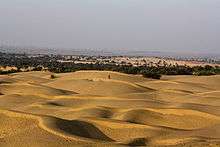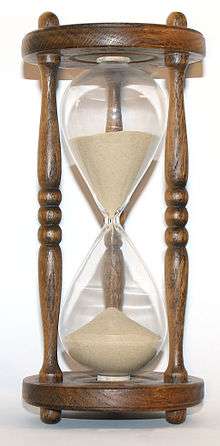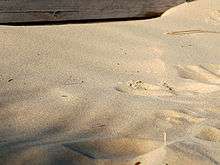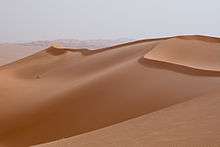
Sand is a naturally occurring granular material composed of finely divided rock and mineral particles.
Quotes

- A wise man can pick up a grain of sand and envision a whole universe.
- By Jack Handey in QuotationsBook.com. Quotes about Wisdom. Quotations Book. pp. 15–. GGKEY:56Q6ULJ32RP.
- People you influence for Jesus Christ will be the lasting legacy of your life. They will be foot prints in cement, not sand.
- In Marion Gaskins (23 October 2008). Footprints In The Sand...Making A Difference...One Step At A Time. Lulu.com. p. 4. ISBN 978-0-557-01422-4.
- And it stood still upon the sand of the sea. And I saw a wild beast ascending out of the sea, with ten horns and seven heads, and upon its horns ten diadems, but upon its heads blasphemous names. Now the wild beast that I saw was like a leopard, but its feet were as those of a bear, and its mouth was as a lion’s mouth. And the dragon gave to [the beast] its power and its throne and great authority.
- I wrote my name upon the sand;
I thought I wrote it on thine heart.
I had no touch of fear, that words,
Such words, so graven, could depart.- Letitia Elizabeth Landon, Friendship's Offering, 1827, Song - I wrote my name upon the sand.
- You may smile at the fanciful structures I rear,
And say, that my castles are built but on sand ;
Like bubbles, that on the blue waters appear,
That sparkle, invite, and then sink from the hand.- Letitia Elizabeth Landon, The Fate of Adelaide (1821), 'Castle Building'
- As Sand (Kmo hol)
When God in the Bible wants to promise
He points to the stars. Abraham goes out of his tent at night,
And sees lovers.
As sand on the shore, God says,
And man believes. Even though he understands,
That saying as sand is only figurative language.
Since then sand and stars have been combined In the net of man's imagery.
Perhaps It's not worth including man here. He was not being referred to ,
There, at the time.- Glenda Abramson (1 January 1989). The Writing of Yehuda Amichai: A Thematic Approach. SUNY Press. p. 7. ISBN 978-0-88706-994-9.
- According to Buddhism sand signifies samsara, or worldly existence that is full of suffering, and water signifies wisdom and thought.
- Wimal Dissanayake (1996). Narratives of Agency: Self-making in China, India, and Japan. U of Minnesota Press. pp. 191–. ISBN 978-0-8166-2657-1.
- One day I heard someone talking about ‘sifting sand’. I liked the sound of those words and scribble in my notebook ‘old man sifts sand’ tells stories…’ and forgot about it. Then one day I was on a beach, watching the sand trickle through my fingers and thought, what if every grain held a story. And what if someone were able to tell those stories by sifting the sand?
- Quoted in The Storymakers: Writing Children's Books : 83 Authors Talk about Their Work. Pembroke Publishers Limited. 2000. p. 83. ISBN 978-1-55138-108-4.
- The sand (Hindi: mitti) in the arena is especially holy to them. In Benares it [sand] comes from the Ganges and is mixed with Ganges water, mustard oil, and turmeric in order to keep it soft and supple. On special occasions, milk and clarified butter (ghi) are also added. The ground must be turned, loosened, and renewed periodically. Only the master (Hindi:ustad) is allowed to enter the new sand after he has honoured it with flowers and incense. The young men not only rub themselves with sand, they also wallow in it. Sand is the balm for their heroism.
- “Arena“ is the area where wrestling is held in p. 1
- Axel Michaels (January 2004). Hinduism: Past and Present. Princeton University Press. p. 276–. ISBN 0-691-08952-3.

- The more sand that has escaped from the hourglass of our life, the clearer we should see through it.
- By Jean Paul in Wendy Toliver (1 January 2005). The Little Giant Encyclopedia of Inspirational Quotes. Sterling Publishing Company, Inc.. pp. 18–. ISBN 978-1-4027-1159-6.
- Georgescu-Roegen compared the Earths’ resources to an hourglass full of sand in which the sand in the upper part of the hour glass represented the store of the low-entropy resources. Its rate of movement in to the bottom of the hour glass was its “flow” controlled by rates of solar inputs. As the rate of low-entropy resources diminished, the amount of high entropy waste (in the bottom of the hour glass) increased and accumulated. Some of the upper sand coalesced into clumps and might move through the neck of the hourglass all at once, analogous to the fossil fuels that might accumulate large quantities of solar energy and then can be tapped at higher rates of flow. But regardless of the rate of flow, the sand in the upper half is destined to run out.
- Quoted in Fred Van Dyke (29 February 2008). Conservation Biology: Foundations, Concepts, Applications. Springer. pp. 399–. ISBN 978-1-4020-6890-4.
A Grain of Sand: Nature's Secret Wonder (2008)

A Grain of Sand: Nature's Secret Wonder. Voyageur Press. 2008. ISBN 978-0-7603-3198-9.
- There are as many stars in the universe as all the grains of sand in the beaches of the world.
- In p. 19
- The huge variety of sand grains is astounding, and each one has a story to tell.
- In p. 23
- Examining sand grains trough the microscope is a wonderful way to find out about the biology, and ecology of the local environment.
- in p. 24
- Every grain of sand is a jewel waiting to be discovered.
- In back page.
- When we walk along a beach, we tread upon millions of years of biological and geological history.
- In back page.
Sand: The Never-ending Story (2009)
Michael Welland (January 2009). Sand: The Never-ending Story. University of California Press. ISBN 978-0-520-25437-4.
- Who could ever calculate the path of a molecule?
How do we know the creations of worlds are not
determined by falling grains of sand?- By Victor Hugo in Les Miserable quoted in p. 1
- For nature is the noblest engineer, yet uses a
grinding economy working up all that is wasted
to-day in to to-marrows creation;not a superfluous
grain of sand for all ostentation she
makes of expense and public works.- By Ralph Waldo Emerson quoted in p. 1
- To see a world in a grain of sand/And a heaven in a wild flower.
- William Blake quoted in p. 2
- For Look! Within my hallow hand,
While round the earth careens,
I hold a single grain of sand
And wonder what it means.
Ah! If I had the eyes to see,
And brain to understand,
I think the Life’s mystery might be
Solved in the grain of sand.- By Michael Welland in p. 3
- The birth of a sand grain is a microscopic event, a flap of butterfly’s wings heralding greater change and a larger creation. Each grain carries the equivalent of the DNA of its parents and develops a character through its life and is moulded partly by its environment. Compared to the scale of a human life, however, the sand grains’ story is never ending, and rebirth is a regular event.
- By Michael Welland in p. 3
- Close to 70 percent of all sand grains on the earth are made of quartz.
- By Michael Welland in p. 4
- The mine which Time has slowly dug beneath familiar objects is sprung in an instant; and what was rock before, becomes but sand and dust.
- By Charles Dickens in Martin Chuzzlewitt quoted in p. 5
- The sand grain has become a symbol of permanence and fragility of our – and - nature’s works.
- By Michael Welland in p. 5
- It has been estimated that on the order of a billion sand grains are born around the world every second.
- By Michael Welland in p. 5
- The sand grain is anonymous, waiting for rain and wind to sweep it away on an endless journey, to demonstrate its durability while its weaker companions fall by the way side. But it is called sand not because of what it is made of or its origins, bit because of how big it is.
- By Michael Welland in p. 6

- Sand is somewhat like beauty – we know it when we see it, or touch it, but it seems difficult to describe.
- By Michael Welland in p. 6
- In no other science does the problem of terminology present as many difficulties as in geology.
- By Chester Wentworth quoted in p. 6
- Sand grains comes in variety of shapes, which can make measuring its size quite tricky.
- By Michael Welland in p. 14
- There are countless sand collectors around the world, and there have been for a long time. …Sand collectors call themselves as arenophiles or “sand lovers”- a mixture of Latin and Greek. The word arena derives from the ancient Roman habit of covering the ground in amphitheaters with sand (harena or arena in Latin) – to soak up blood. The pure Greek would be psammophile, and some sand collectors use this but it is commonly used also to describe plants and creatures that are sand-loving, forging a livelihood among the grains.
- By Michael Welland in p. 14
- ...the entire universe was there within a grain for our understanding.
- By Gottgfried Leibniz quoted in p. 29
- ...the noise made by a single grain of sand moving with the waves is one of a series of tiny perceptions that we accumulate to hear the roar of the ocean.
- By Samuel Beckett quoted in p. 29
- It isn’t the mountain ahead that wears you out – it is the grain of sand in your shoe.
- By Robert Service quoted in p. 30
- A single grain of sand can have an influence far out of proportion to its size, but when it gathers together with vast numbers of its colleagues, very strange things can indeed happen.
- By Eddy Arnold on “One grain of sand" quoted in p. 30
- History is a child building a sand castle by the sea and that child is the whole majesty of man’s power in the world.
- By Heraclitus ca.535-475 B.C quoted in p. 31
- And so castle made of sand fall into the sea, eventually.
- By Jimi Hendris quoted in p. 31
- Albert Einstein described the left-hand side of the equation for his general theory of relativity as built on granite, the right-hand side on sand.
- Quoted in p. 33
- Reflecting its potential fluidity and fickleness, sand, as the quintessential granular material, has become a symbol of instability and impermanence. The biblical admonition against building a house on sand may be exaggerated.
- In p. 33
1,600 Quotes & Pieces of Wisdom That Just Might Help You Out When You're Stuck in a Moment (and Can't Get Out of It!) (2003)
Gary Guthrie (1 March 2003). 1,600 Quotes & Pieces of Wisdom That Just Might Help You Out When You're Stuck in a Moment (and Can't Get Out of It!). iUniverse. pp. 50–. ISBN 978-0-595-27404-8.
- Relationships – of all kinds – are like sand held in your hand. Held loosely with an open hand, the sand remains where it is. The minute you close your hand and squeeze tightly to hold on, the sand trickles through your fingers. You may hold on to some of it, but most will be spilled. A relationship is like that. Held loosely, with respect and freedom for the other person, it is likely to remain intact. Held too tightly, too possessively, and the relationship slips away and is lost.
- By Kaleel Jamison in p. 50
- If you speak ill of another do not speak it...write it in the sand near the water’s edge.
- By Napolean Hill in p. 54
- Be master of your petty annoyances and conserve your energies for the big, worthwhile things. It isn’t the mountain ahead that wears you out – it’s the grain of sand in your shoe.
- By Robert Sinclair in p. 115
The Everything Buddhism Book: A complete introduction to the history, traditions, and beliefs of Buddhism, past and present (2010)

Arnie Kozak (18 December 2010). The Everything Buddhism Book: A complete introduction to the history, traditions, and beliefs of Buddhism, past and present. Everything Books. pp. 203–04. ISBN 1-4405-1163-2.
- A sand painting is exactly what it sounds like –a painting made of sand. Sand paintings represent the impermanence of all things. Mandalas are often maps of spiritual world. They are usually represented in artwork as a graphic symbolism pattern. The pattern is usually in the form of a circle with intricate designs within. The patterns are representative of the sacred place where Buddha or deity abides. They are used for contemplation and meditation and are designed to awaken spiritual potential.
- Sand painting are often mandalas. Tibetan lamas create them to promote healing. Sand paintings are made with vegetable-dyed sand, flowers, herbs and grains, stone and sometimes jewels. A platform is laid out and the sand and other materials are placed on the platform over a period of time that serves as a meditation. Once the platform is in place the lama will start a healing ceremony that blesses the area. When the sand painting is finished, it is dismantled, demonstrating the impermanence in action. After a ceremony, the sand is swept into a large vessel and deposited in a river or a lake, again with ceremony.
- Native Americans are also known for their sand painting mandalas. Many similarities can be found between the Navajo sand paintings and the Tibetan sand paintings. Both contain images of the cosmos in a circular form.
- For centuries Japanese Zen masters created gardens out of rocks and sands, raking the sand into patterns that could be destroyed quickly, like the sand paintings, emphasizing the impermanence of all things.
Oxford Treasury of Sayings and Quotations (2011)

Susan Ratcliffe (13 October 2011). Oxford University Press. pp. 7–. ISBN 978-0-19-960912-3.
- In every out thrust headland, in every curving beach, in every grain of sand there is the story of the earth.
- In p. 134
- Sand is overrated. It’s just tiny little rocks
- In p. 256
- There’s sand in the porridge and sand in the bed . And if this is the pleasure we had rather be dead.
- In p. 109
- Laws are sand, customs are rock.Laws can be evaded and punishment can be escaped, but an openly transgressed custom brings sure punishment. Page 109
- In p. 439
- Built on sand, lacking a firm foundation, unstable, ephemeral, from the parable in the Bible (Mathews) of the two houses founded respectively on rock and on sand.
- In p. 181
- Plough the sand, labour uselessly, a proverbial type of fruitless activity
- In p. 181
